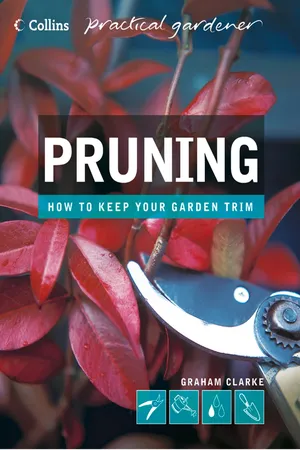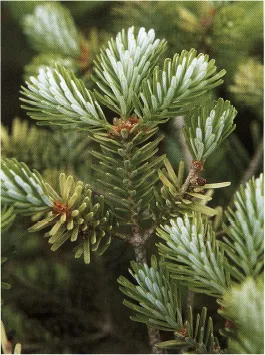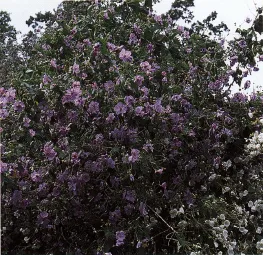
This is a test
- English
- ePUB (mobile friendly)
- Available on iOS & Android
eBook - ePub
Pruning
Book details
Book preview
Table of contents
Citations
About This Book
Pruning is the number one anxiety of aspiring gardeners who want to train and stimulate their plants but fear they might kill them. Pruning now joins the hugely successful Collins Practical Gardener series to give you the best tips and techniques for pruning your entire garden, from roses and fruit trees to hedges and topiary plants.
Frequently asked questions
At the moment all of our mobile-responsive ePub books are available to download via the app. Most of our PDFs are also available to download and we're working on making the final remaining ones downloadable now. Learn more here.
Both plans give you full access to the library and all of Perlego’s features. The only differences are the price and subscription period: With the annual plan you’ll save around 30% compared to 12 months on the monthly plan.
We are an online textbook subscription service, where you can get access to an entire online library for less than the price of a single book per month. With over 1 million books across 1000+ topics, we’ve got you covered! Learn more here.
Look out for the read-aloud symbol on your next book to see if you can listen to it. The read-aloud tool reads text aloud for you, highlighting the text as it is being read. You can pause it, speed it up and slow it down. Learn more here.
Yes, you can access Pruning by Graham Clarke in PDF and/or ePUB format, as well as other popular books in Biological Sciences & Horticulture. We have over one million books available in our catalogue for you to explore.
Information
Ornamental Woody Plants
The following ornamental woody plant directory offers practical information on pruning and training the trees, shrubs and climbing plants most commonly found in our gardens.

Acer palmatum

Choisya ternata
There is one sentence you will not see too often in this directory section, yet it is vitally important for the welfare of woody plants: when pruning, always cut out dead, diseased or damaged wood, when seen. This applies to every type of woody plant, regardless of the normal pruning season. If you leave unpruned any dead or diseased wood, healthy tissue will become infected; likewise, if a branch is damaged, then there are multiple entry points for air- and waterborne infections. So, even though this sentence is not repeated hundreds of times throughout the text, you should be aware that it applies to every plant entry appearing on the following pages.
Abies | Fir |
EVERGREEN CONIFER
General: These conifers do not pose any significant pruning challenges for the gardener. From the moment a seedling of Abies is manageable, it is important that a single leader is selected. Once planted in its permanent quarters you should allow the leader, and all side branches, to grow unchecked. Any branches which are seen to be damaged, or are dying back, should be removed to the trunk. No other pruning is normally necessary.

Abies koreana
Abutilon |
EVERGREEN/DECIDUOUS SHRUB
General: All species are tender, and if grown outdoors are best protected by a south-facing wall. Although these are short-lived plants, often exhausting themselves in three or four years, they do repay by flowering over a long period in summer. They flower on current season’s growth. Before growth starts in earnest in mid-spring, cut out any winter damage, and thin out crowded shoots.
Special requirements: Abutilon x suntense is a spectacular hardy hybrid which tends to blow over unless it is fairly hard pruned after flowering, in late spring or early summer.
A. vitifolium should be treated as a freestanding shrub; the only pruning needed is dead-heading, in mid-summer.
The trailing abutilon, A. megapotamicum, grows long, slender stems, and it is ideal for training against a wall. The form ‘Variegatum’ has yellow-mottled leaves. With a wall-trained specimen, cut away old wood in early to mid-spring, and tie in the strong young replacement shoots.

Abutilon x suntense
Acacia | Silver wattle |
EVERGREEN SHRUB/TREE
General: Native of Australasia, acacias succeed only in mild districts, and are best grown in the shelter of a warm wall. The only pruning required to keep a mature specimen producing its masses of tiny yellow blooms each spring is to remove old, spent flower shoots, dead wood (of which there tends to be a large amount each year), and any frost-damaged tips. This is best carried out soon after flowering is over, during mid- to late spring, and ideally when you know there are no more prolonged frosts until autumn.
Special requirements: Most acacias resent hard pruning, and do not regenerate successfully. However two exceptions to this are Acacia dealbata and A. melanoxylon; both are suckering species. Vigorous species (such as A. dealbata and A. longifolia) can be cut back hard when young to encourage branching low down. Some forms, including A. cultiformis and A. verticillata can be clipped regularly, and make acceptable informal hedging.
Acer | Maple |
DECIDUOUS SHRUB/TREE
General: There are a large number of acers, varying in height, habit and decorative value. It is the smaller Japanese maple (Acer palmatum) which is most commonly seen in gardens. These acers tend to branch low; if they do not, a little judicious pruning whilst they are young will encourage them.
There are dozens of Acer species that make wonderful specimen trees. Many are grown for their ornamental barks, whilst others have desirable shapes and leaf sty...
Table of contents
- Title Page
- Copyright
- Contents
- Introduction
- Assessing Your Garden
- Reasons for Pruning
- Tools & Equipment
- Understanding Plants
- Pruning Techniques
- Pruning Roses
- Hedges & Topiary
- Ornamental Woody Plants
- Pruning Hardy Fruit Trees
- Pruning Exotic & Tender Fruits & Nuts
- Pruning Soft Fruits & Vines
- The Pruner’s Glossary
- The Pruner’s Year
- Keep Reading
- Acknowledgements
- About the Publisher